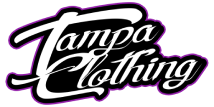If you look at recent trends, you can see that more people are wearing custom-printed shirts instead of normal T-shirts. This is simply because people today like personalization. They love to wear shirts that represent their individuality or help them reflect a purpose.
Custom printed Company shirts can be an effective form of marketing due to their visibility. Printed shirts with the business logo or colors also help promote brand recognition and boost public interest.
With the new scope of custom printing, bulk shirt printing has become insanely famous. It is because this helps a group of people connect and share a bond. Whether it is a corporate event, family occasion, social event, or a themed party, custom-printed shirts are one of the first requirements!
If you plan to get some printed shirts in bulk for your next big event, go through these types of shirt printing & consider the cost of custom shirts before deciding.
In this blog, we provide insights into the popular kinds of shirt printing. We also give you an idea about how they work, their costs and different options for logo placement on shirt. It will help you decide the best type of shirt printing. Let’s take a look.
What Are the Different Types of Shirt Printing?
There are different types of shirt printing. They have certain characteristics or uniqueness and also vary in levels of complexity. Read ahead to know the types and decide for yourself!
1. DTG
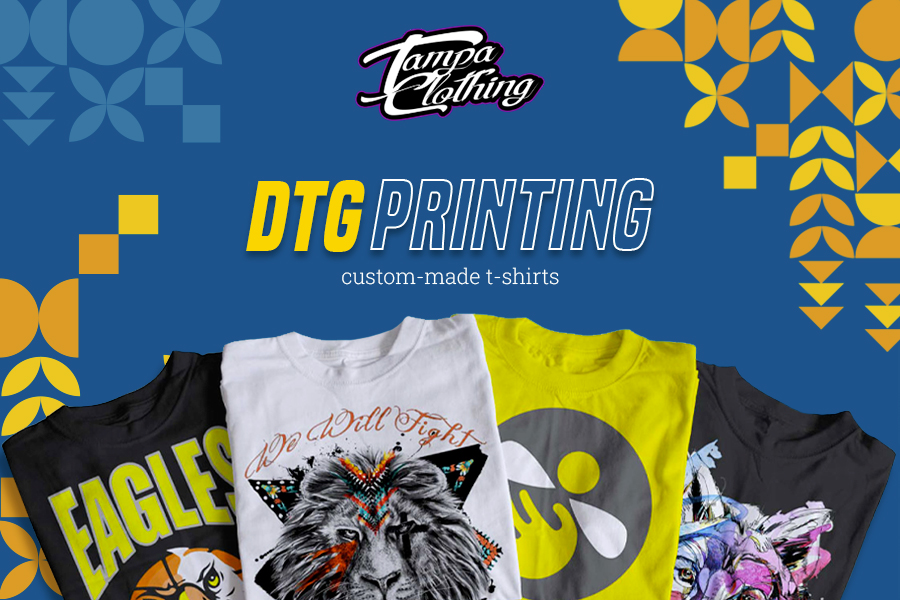

DTG, a short form of Direct to Garment printing, is the most appreciated method of corporate or professionals for custom-made T-shirts.
It is similar to normal paper printing where one uses ink and printing is done with a textile printer. It is an instant process and provides immense scope for personalization with various colors and graphics.
If you want to print a shirt with a detailed design or intricate graphics, this is one of the best type of T-shirt printing used by custom apparel manufacturers. You can create the design using a Photoshop application and print them on your shirt in an exact way.
How It Works?
The process of DTG printing is extremely simple, yet gives amazing results. You need a specific fabric printer where you have to feed the design created on the Photoshop application. You can even use a photo to print on the shirt. The printer transfers every detail of your design or photo with precision to the shirt.
This process is that the design does not get on the shirt as a separate layer on the fabric. But the ink immerses well into the fabric. Hence, the design feels smooth when touched. However, be sure to use designs with thin lines as there is no scope for using thick lines.
Who It’s For?
DTG printing is generally used for bulk printing due to its capability to print shirts fast and instantly. Big companies, factories, and public event organizers use DTG. It is also used by institutes to provide its members with a common T-shirt.
PROS and CONS
DTG printing has the following advantages:
- Takes the least time, which makes it ideal for bulk shirt printing
- Requires no complex steps and is simple to print.
- Allows a lot of colors and design variations
- The designs on the shirt feel soft and perfect
This sets it apart from DTF printing. Here’s a detailed analysis of ‘DTG vs DTF‘.
DTG printing has some drawbacks too:
- The textile printer is quite expensive
- Need professionals who use a high-quality printer
- Need to be handled carefully and maintained regularly
How Much Does It Cost?
The high cost of the printer makes this type of shirt printing expensive. It is not at all the ideal option for printing a single or a few shirts.
2. Indirect Screen Printing/Plastisol
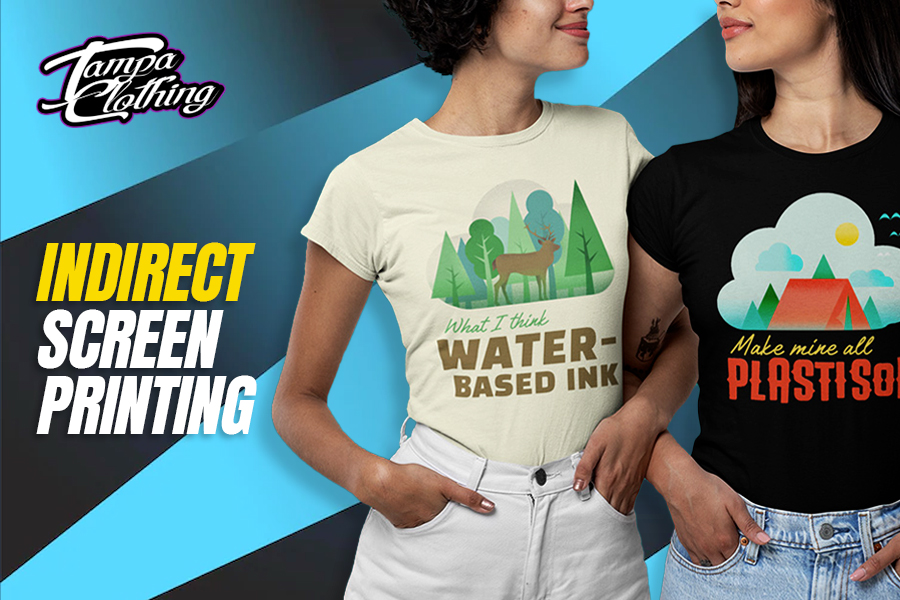

Indirect screen printing uses a similar method of the screen printing method and plastisol ink.
It is widely famous among the different types of T-shirt printing because of its versatility and ease of application.
This method is not suitable for home-based shirt printing but is highly efficient for commercial printing. By that we mean, you can print shirts in large volumes.
T-shirt screen printing is one of the conventional methods, which is durable. It gives room for creativity, sophisticated designs, colors, and complex designs. This method is also convenient for bulk shirt printing.
How It Works?
If you want custom screen printing with plastic, then create the design on your computer or tablet and share it with the printing agency. The technicians will put the design on a plastisol transfer sheet with ink, and then the sheet is then heat-pressed into the shirt.
In this method, you cannot feel the softness of the design with the fabric. Instead, you can feel the design on the fabric as a separate layer.
The amount of ink you need to print each shirt depends on various factors, like the size and type of design matter. Also, look into the squeegee pressure, the mesh count, and the lines or strokes matter.
Who It’s For?
Indirect screen printing is suitable for various companies, factories, organizations, delivery businesses, etc. It is done to provide uniformity for regular wear to their resources.
PROS and CONS
The indirect screen printing type is known for the following advantages-
- Inexpensive for printing larger volumes of shirt
- Faster printing
- High-quality prints that last long
- Suitable with most types of fabrics
However, be ready to face these drawbacks if you choose this custom screen printing method.
- A messy process that can be handled only by professionals
- Limited area for the design or artwork
- Requires a clean and dust-free space
- How Much Does It Cost?
Screen printing is known for being an inexpensive method. That’s the key reason most business owners or organizations prefer it. On average, the cost of shirt screen printing is very low. The price depends upon the design size and the intricacy of the artwork.
3. Heat Transfer Vinyl
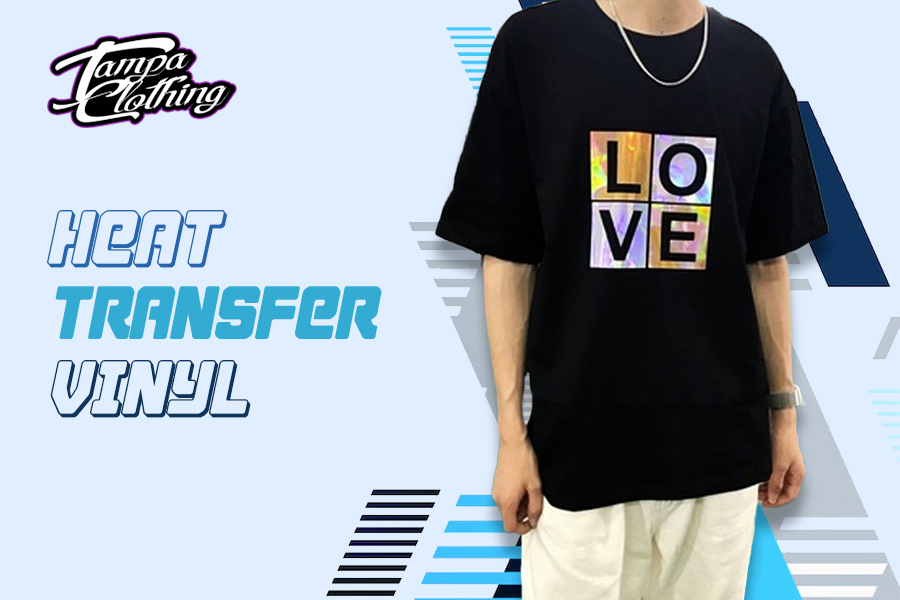

The Heat transfer is a kind of permanent vinyl. One can use it to print blankets, t-shirts, pillows, etc. It is one of the most common types of shirt printing methods.
All you need to do is cut the design, words, or logos from the vinyl and use high temperature to seal the shirt.
Many use it to get long-lasting and raised images on shirts. Some artists appreciate the simple method. For large-scale professional-level orders, one would mostly require commercial equipment to create vinyl designs. Choosing vinyl will also give you several variations of basic vinyl laminate.
This includes metallic, glitter, flocked, or velvety vinyl. It requires a basic electronic device. If you want to make custom shirts for your home or need small orders, it will give you great flexibility. The design can sustain more than 50 washes.
How It Works?
If you choose Vinyl shirt printing, here’s a sneak peek into how it works. Vinyl comes from the carrier sheet, which is the same as transfer tape. You put it on a mat with a face-down method.
Before applying it to a shirt, you have to reverse the design and put even pressure on both sides. Once you are happy with the design you may take off the carrier sheet and remove the vinyl from the shirt.
Through this method, you can make a design on a sheet of vinyl. After that, you can transfer it onto a shirt. You can apply heat transfer vinyl to any kind of t-shirt with top-quality designs.
The process is tricky, and only professionals can handle it meticulously. Once you have tried this method, there is no going back. Among the various methods of shirt printing, this is one of the best types of shirt printing.
Who It’s For?
If you are looking for an alternative for types of shirt printing, Vinyl is an option. You can choose various textures and colors of heat transfer vinyl. Whether you need to design a logo or for a special occasion, you can choose vinyl. There will be several options to use colors and textures of your choice.
PROS and CONS
HTV or heat transfer vinyl is known for the following advantages-
- Cost-effective
- Easy to use
- Long-lasting
There are a few drawbacks to this method. Some of them are as follows-
- Inapt for shirts that are susceptible to high temperatures
- Not the best choice for large-scale production
- Doesn’t work on dark colored
How Much Does It Cost?
Vinyl printing is a preferred option for many small businesses and individuals. If you choose heat transfer vinyl, you can go for it because it is highly cost-effective. Depending on the type of design, print location on the shirt, and size of the print, the price may differ.
4. Heat Press Printing
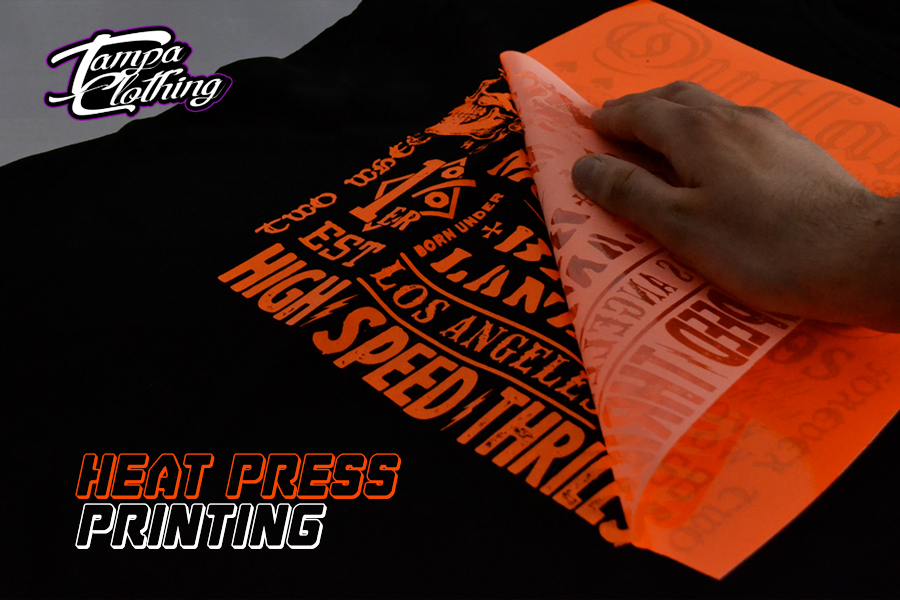

Heat press printing is a common and well-known option for many. The heat press is a device used to print on a chosen surface.
Choose your preferred design and get a printed shirt. Usually, this method takes place on t-shirts. There are mainly two types of heat press- manual and automatic.
If you want to print shirts in high volume, use the automatic option. Most heat presses work very well on a variety of fabrics. The patterns come out quite well via this method. However, there is still no particular type of press that prints a chosen design on other objects like hats, notebooks, or coffee mugs.
This method is quite similar to dye sublimation but has minor differences. It is appropriate for small quantities of t-shirt printing orders and if you want to experiment with designs, go for heat press printing. It is an easy way to do it.
The outcome after using such a method is a durable and rich-looking design.
How It Works?
A heat press is a device that prints a pattern on a substrate of your choice. Generally, the substrate is a T-shirt or other form of cloth. It effectively transfers the intended print onto the substrate by applying pressure and heat for a predetermined period.
The essential material for this kind of printing is transfer paper. Once your design gets printed on the transfer paper, you can apply heat and pressure to copy it on a shirt.
When it’s done, the transfer paper is removed and stripped of the excess dye. It is a simple process and a fascinating kind of replication.
Who It’s For?
Heat press printing is an economical method, useful for home production. You will get unlimited designs and good-quality work if you choose this printing method. This technique, like similar ones, is most effective with lighter textiles.
Additionally, it is inappropriate for fabrics with a low heat tolerance. When you opt for this printing method, be careful to pre-check the specification and the care directions for shirts so that the fabric remains intact.
PROS and CONS
Some of the benefits of using heat press printing are-
- Swift work
- Affordable
- Simple process
- Option of using any design on any fabric
- Can replicate complicated designs
A few drawbacks of heat press printing-
- A bit expensive
- Time-consuming
- Cannot be used on heat-sensitive fabrics
How Much Does It Cost?
Due to several variables, the cost varies substantially. The prices are different depending on the print size, amount of order, fabric, location of the print on the shirt, shipment process charges, colors, and textures used. You can talk to companies or experts to know the average price of printing different types of shirts.
5. Dye Sublimation
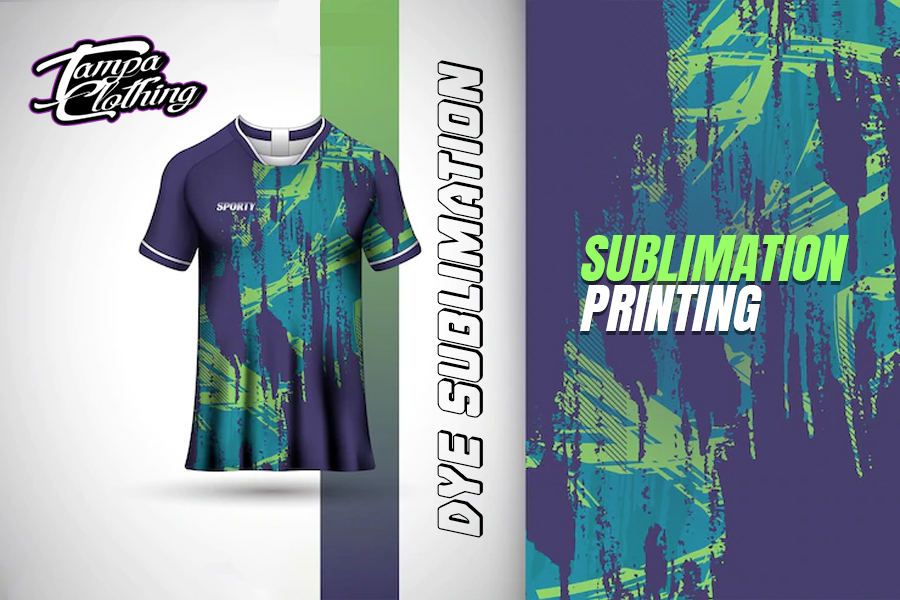

Among the many different types of shirt printing, dye sublimation comes next on our list. It is an advanced form of technology under digital printing.
It uses heat to transfer a picture to its designated substrate or surface. Digital sublimation or dye is a standard method to design signs, apparel, and banners.
This method is best for large complex designs. One thing to remember about this method is that you can only use it for light fabrics like polyester.
But if you try this method on cotton, the outcome will be horrible. Dye Sublimation provides high-end results, but knowing how to use it is important.
How It Works?
Sublimation t-shirt design is the best option to create attractive graphic designs. If you choose natural fabrics as a printing surface, then this method won’t work. By using dye sublimation, you use a special dye. Two stages are necessary for the dye sublimation printing procedure.
One prints the images using the sublimation printer and ink onto the transfer paper. The designs are then converted to gas using heat, which adheres to the cloth.
The best thing about this approach is that it produces endearing and durable designs. The ink gives the impression of being a part of the material, which makes it perfect for high-end, expert effects.
Who It’s For?
If you choose this printing method, it would be one of the best choices. Keep in mind that you need very light fabric for the print to work. Those who have multicolored designs can choose due to sublimation.
PROS and CONS
- You can use dye sublimation for the following benefits-
- It creates breathable prints
- Premium quality prints that won’t crack, peel or fade
- Produce super soft and smooth, soft-printed garments
- Good for large-sized designs
- Print it on multiple surfaces like ceramics, signage, acrylics
- Long-lasting product
- The risk of mistake is less
- An appropriate choice for an endless number of colors and patterns
There are a few reasons to avoid this method. Read the drawbacks of Dye Sublimation Printing-
- You can use only fabrics made of polyester
- The procedure is reasonably expensive if you choose for small business
- Armpit areas and other creases are a challenge to color
- It is slower than inkjet
- It may require added labor work leading to increased costs
How Much Does It Cost?
Dye sublimation is an excellent choice for printing on a piece of fabric or a large garment. You will get more designs. If you choose this method, know that the dye sublimation printer price varies.
The printing charges will differ because of factors like the size of the print, the location of the print on the shirt, fabric (polyester shirts for sublimation), shipping (if needed), design type, etc.
6. Heat Transfer Printing/Inkjet
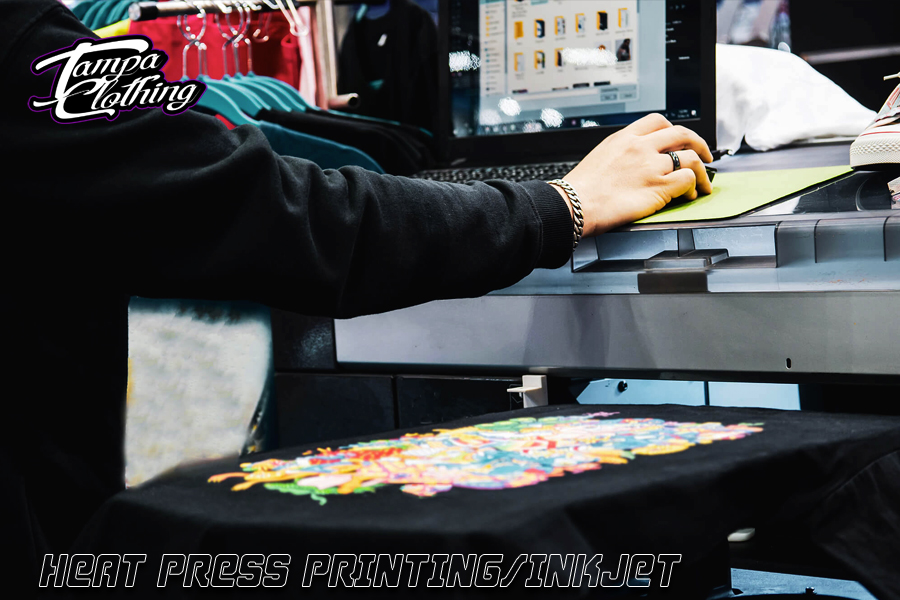

Heat Transfer printing, also known as thermal printing or thermal-wax transfer, lets you print a design on particular clothing or object.
It is the application of ink-based designs on a particular product (mostly shirts) with a top-quality heat press machine. You can use different processes for heat transfer printing.
It is similar to the heat press approach. You may also have your design printed on vinyl and then apply the vinyl on the shirt using a heat press. In any case, the technique is reasonably simple. It is done by utilizing an inkjet printer to print the pattern onto a transfer.
You don’t require a pricey printer or a large number of specialized supplies. Each transmission must first be set up, and only then can it be heat-pressed into the garment.
How It Works?
Such types of clothing printing are quite popular. In this type of shirt printing method, an inkjet printer smoothly prints a sheet of specially made transfer paper with excellent-quality ink. The paper is then laid on your shirt, and one applies the heat press for a few seconds. But the time for heat press may vary depending on the type of material and print you use.
For garments with light colors, the professionals use the mirror of the original picture and print it on paper. After this, the transfer procedure puts a mirror of the original mirror picture on the shirt.
But for dark shirts, they print the design without the mirroring process. This is because such printers cannot print white.
Thus on white shirts, the only thing necessary to do is not to print the white areas of your design. The original color shows through. Dark garments need specific transfer papers enclosed with transportable white ink. So, make your own custom shirts and enjoy its perks!
Who It’s For?
You can use it for high-quality, colorful, photo-realistic work. People use this type of printing for its realistic photo finish for promotional events or as a novelty gift.
Professionals can give you a riveting finishing product with this method. Heat transfer is often used for number or name printing on sports kits. It works best when it gets exposed to some elements, which prevents them from fading or getting damaged.
PROS and CONS
Let’s look at some of the advantages of this method-
- Heat resistant
- Durable
- Water-resistant
- Adhesive
- High-resolution and bold colors
Some of the disadvantages of such shirt printing types-
- It is a time-consuming process
- Professionals prefer it less because of time consumption
- Creates a solid layer on the shirt making it uncomfortable to wear
- Only light or white shirts can show the design
How Much Does It Cost?
As with all printing methods, this one has its pros and cons but is still used by many. The cost of heat press printing can vary depending on your requirement.
When deciding whether to use customized heat transfer consider factors like the complexity of the color, the available fabrics, the design, the durability, and the amount of your order.
7. Screen Printing
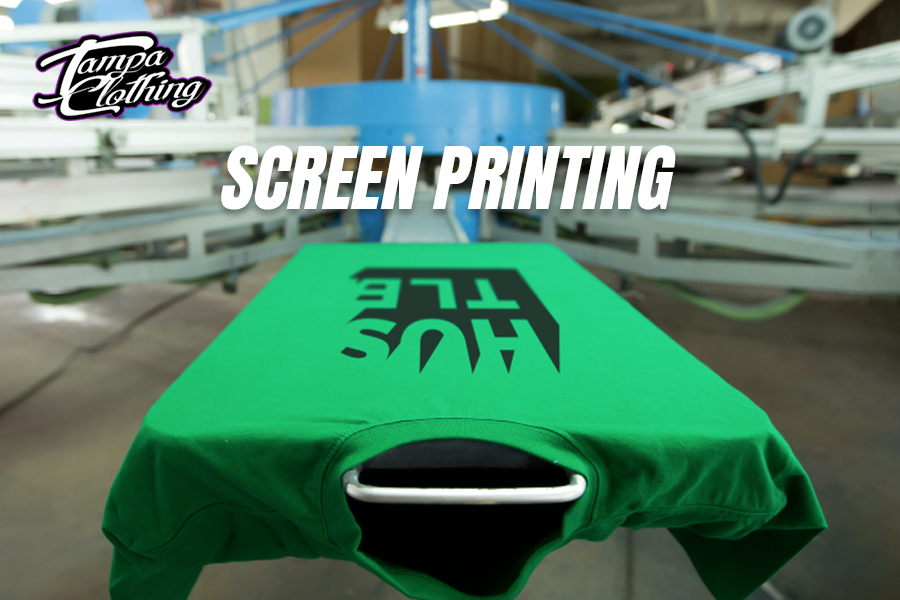

Different types of shirts require distinct printing methods. The method of screen printing involves applying a stenciled image to a flat surface, often made of paper or cloth.
As long as it’s flat, you can transfer almost any picture on a fresh surface by using a squeegee, mesh screen, ink, or straight blade. Other than cloth and paper, you can choose to use screen printing to decorate surfaces made of metal, glass, wood, and polymers.
Read our detailed guide on heat press vs screen printing to make an informed choice.
How It Works?
An expert should guide you in such matters, but if you do it yourself, this is how it’s done. You must first have the stencil (or template) that you wish to use. You also require a mesh that can hold your stencil.
Typically, nylon or another synthetic material is used to create the mesh. The mesh must undergo a pre-process before printing can begin. Its objective is to get a clear, identical-to-the-design region in the mesh.
The mesh must then be coated completely with ink before being pressed with a squeegee to ensure even coverage.
This procedure makes sure that your design is accurately reproduced on the t-shirt. If there is any extra ink, don’t panic; you can wipe it off. Finally, when you take off the screen, give it time to dry. You can then enjoy the design.
Who It’s For?
For those who are filled with tons of orders, these types of shirt printing methods are quite effective. But if you just started your business or have a tight budget, screen printing may not suit you. If you want to promote your business, this is one option, as businesses will not want to spend a huge lump sum.
Screen printing gives you a high-quality outcome but is not suitable for all kinds of printing. Big and reputable companies rely on this method as the stencil can be used repeatedly for mass production.
For complex designs, screen printing may not be the best option, but for single-color or multicolored prints, you can choose this one.
PROS and CONS
Some of the advantages of using such types of shirt printing techniques-
- Finest for huge orders
- Numerous printing options
- Can print very minute details of the design
- Highly versatile: most shirts can be screen printed with no complexity
- Durable print (surviving many washes)
Like everything has its advantages and disadvantages, screen printing has its drawbacks too. Here are some of them-
- Needs the least order amount to be inexpensive
- One print at a time makes it time-consuming
- Higher costs if you add more colors
How Much Does It Cost?
Costs of all kinds of printing differ due to the requirement type, design type, size of the order, and reason to use them. You can ask experts in this field to get an idea about the cost.
Remember that there are several options for different types of shirt printing. Choose the one that suits you and enjoy the results.
8. Airbrushing
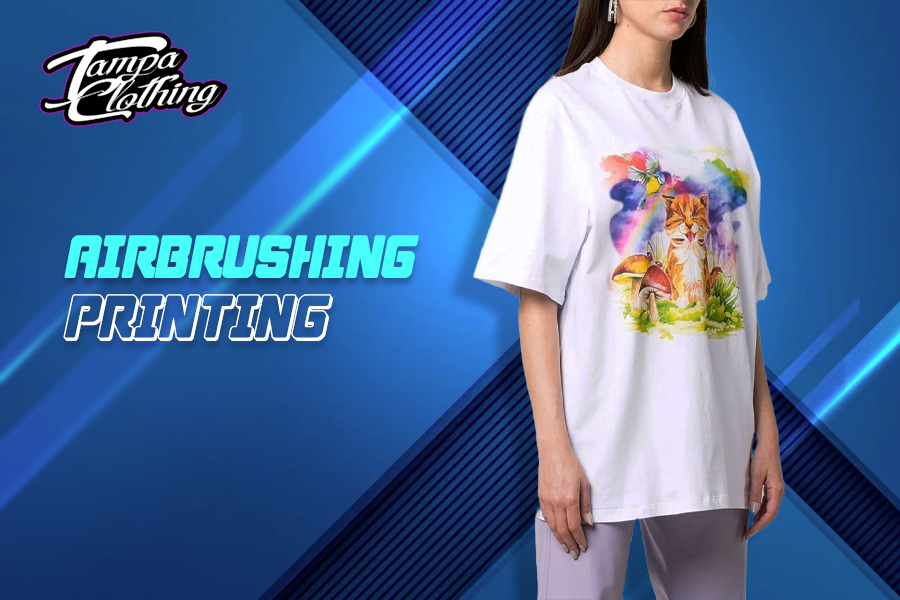

Airbrushing has turned out to be quite a trendy method today. In the age of technology, machines are mostly used today to print on cloth. But we shouldn’t disregard the conventional approaches of t-shirt printing.
Hobbyists favor this technique because it provides them with a significant amount of room for experimentation and creative expression.
But keep in mind that your skills and abilities will have a big impact on the result. For this kind of printing, it is essential to determine specific colors, spray or fabric paint, fabric type, etc.
There are various types of airbrush kits to airbrush clothes. The one that is used most often is the siphon-feed airbrush. With such methods of printing on shirts, it stands perfect for any material because it can handle higher viscosity fabric paint.
How It Works?
You may find different types of shirt printing machines, but are they as good as the conventional methods? The process of Airbrushing is quite simple.
One can directly apply color to the garment. It’s critical to emphasize that you must examine the fabric quality and suitability of the shirt in advance.
If you choose this option, be sure to get some high-quality paints. You simply spray the color or color right onto the clothing, which is an easy operation. After you’re done, you must wait for it to dry. The colors’ longevity is a problem because lots of them might eventually fade away.
Who It’s For?
Airbrushing is a unique technique that needs high precision. If you are looking forward to getting shirt prints that are easy to maintain, low-cost, and compatible with all fabrics, go for this one. Individuals can use this method for single-unit or small orders, as larger orders would take time to deliver.
PROS and CONS
Some of the advantages of using such types of shirt printing technique-
- Unlimited design options
- Compatible with all fabrics
- The experience of making your shirt manually
- Inexpensive
Certain drawbacks of this technique-
- Lower design quality
- Less durable results
- Not suitable for large quantities (will take time)
How Much Does It Cost?
If you use such types of apparel printing methods, look forward to saving ample money. This is an affordable method. The manual way of printing without machines makes it less costly. Be sure to as industry experts or research this method according to your budget.
9. Discharge Printing
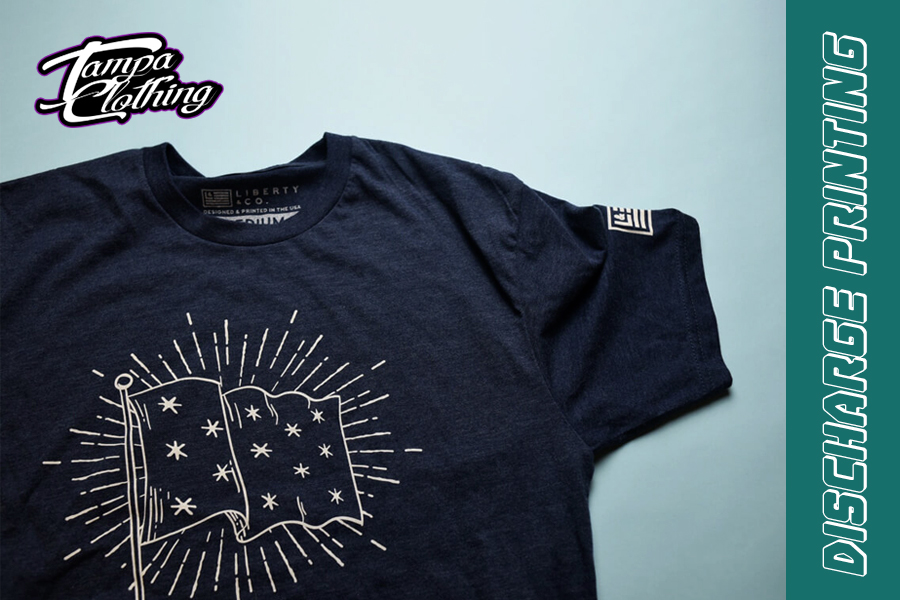

Discharge printing or Extract Printing is a method of applying a design to dyed fabric.
It is not used so much but still has a name. It is done by printing a color-destroying means, such as hydrosulfite or chlorine to bleach out a light or white pattern on the darker-colored base.
Compared to the other different kinds of shirt printing, this one is less common yet produces distinctive shirts. Instead of adding paint, the process requires removing it!
Discharge printing is slightly close to bleaching in a layout, except it doesn’t harm the fabric as bleaching would. It produces a very delicate print that reveals the shirt’s weave. You can use this method without pigments, as an under base for additional colors.
It might be challenging to produce precise color results when pigmenting discharge. This can happen due to the efficacy of the discharge impacting the color.
What you see with your naked eyes is not what the pigments show when mixing. Nevertheless, it can still be a wonderful approach to attain colors in dark clothing. Discharge printing is a safe method as the ink does not produce a skin irritating reaction. It is eco-friendly because of the use of water.
How It Works?
This method is not so different than conventional screen printing. You need to use a stencil by the printer to preserve a portion of the t-shirt design before the remaining color is bleached off. To keep the stencil from breaking down when the printing is in process, you will need special emulsions as well.
You might want to try this method at home with a group to make fashionable t-shirts that appear retro. An impermeable dye is put to the bleaching agent in the color discharge printing to produce a design instead of white on a dyed base.
It is quite gentle on fabric because it’s made out of a water-based discharge agent. For this reason, people use discharge printing on delicate fabrics.
Who It’s For?
If you have a garment that is 100% polyester, such as an athletic shirt, it won’t work since the discharge ink solely adheres to natural fabrics (i.e. cotton).
But if you have blended fabric, for example, half polyester and half cotton, then it may just work. It will give a vintage look but won’t be as vibrant as it should be.
PROS and CONS
The different types of printed shirts technique may have a few benefits and drawbacks. Let’s look into it briefly-
Advantages of discharge printing:
- Distinctive look
- Vintage-style shirts
The disadvantage of discharge printing:
- Time-consuming
- Expensive for individuals and companies
How Much Does It Cost?
It is not more expensive than conventional ink screen printing. With discharge, you can print in several colors even more quickly. This is because you can avoid the process of drying before one puts another layer. Depending on the requirements the cost may vary.
Factors like print type, print size, use of colors, and print medium will create cost differences. Basic research about types of prints in shirts will help you determine what method is best for you.
10. Stenciling
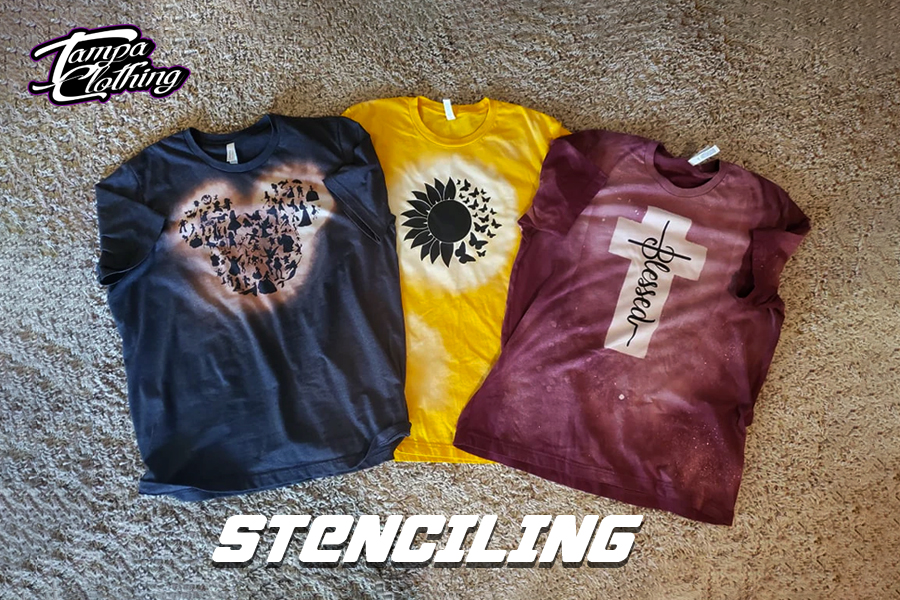

In stencil printing, while one applies a dye to the surface, the pattern elements not meant to take colors are covered by woven cloth, paper, or metal.
Stenciling is a simple way of shirt printing. In processes like screen printing, experts typically utilize more intricate stenciling techniques.
You can make a few bright shirts for your family or friends at home using basic supplies if you only need a handful of shirts. This can be a perfect diy t shirt printing method.
For stenciling, you don’t need a heat press despite its long-lasting quality. One could stencil anything they want on the fabric. Essentially, there are two types of stencil printing on shirts – photo stencils and hand-cut stencils. Both have distinct differences. Stencil printing can be of animals, abstract designs, images, etc.
How It Works?
Stenciling is an attractive finish technique to replicate and produce a specific design. The pattern or image is made by putting some paint on the surface by using a stencil. This is done to apply a pattern or layout on a surface via cut-designed openings.
The easiest sort of shirt printing you can do at home is this one. You may use a more advanced tool, like a Cricut, or cut a stencil by hand. After that, you paint the dye over the stencil to decorate the shirt with a pattern or logo.
Who It’s For?
Although this approach produces results of a high caliber, it is not appropriate for all forms of printing. The stencil may be used again, which is fantastic if you need to create a lot of identical shirts.
The technique works well with one color per screen. Although it can print in several colors, if you need more professional patterns, this may not be the ideal choice.
The stenciling method is ideal for those who want creatively designed shirts and bags. You can do this at home on new and old clothes, shirts, bedsheets, towels, and more.
PROS and CONS
With stencils, you can have the following advantages:
- Make your design as complicated or as basic as you like
- Use equipment you probably already have
- Frequent use is possible
Unfortunately, it has some drawbacks as well:
- It is appropriate for private use
- Will not give a professional style design finish
How Much Does It Cost?
The price of printing might vary greatly. In general, the equipment costs increase as printing speed increases. When you want to start, be careful to strike a balance between the price and the rate of output. You shouldn’t choose a sluggish method if you need to print hundreds of shirts rapidly.
11. Belt Printing
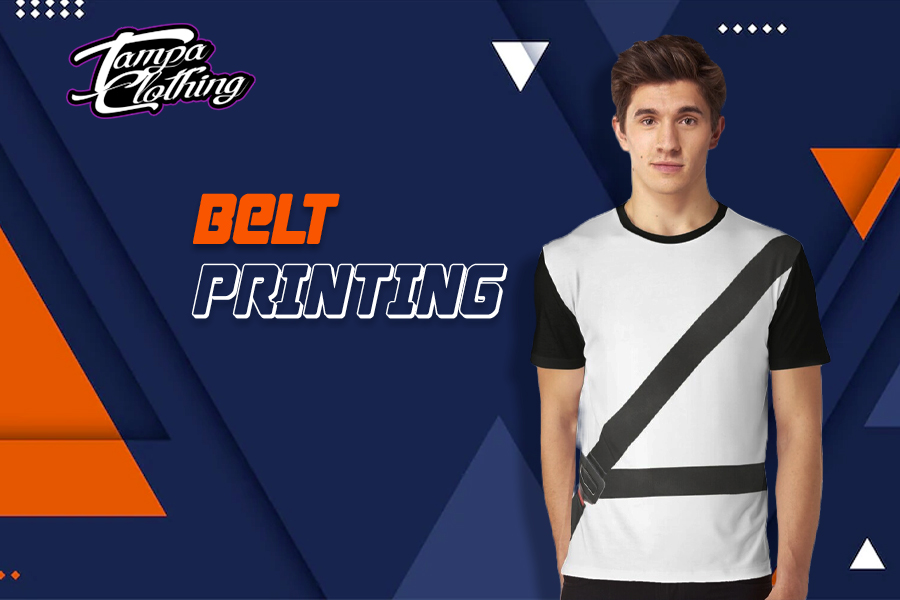

Did you know that the Belt Printing shirt technique has been there for over 20 years? A belt printer uses a straight line with a big belt that transports t-shirts to stations.
It pauses them and then lowers print heads to begin printing, as opposed to a round machine that moves t-shirts on little tables to print heads.
Because historically, the screen print is produced using what is known as “a belt printer,” many individuals refer to this as “Belt Printing.” Belt printers are massive printing devices with enormous screens that imprint shirts.
A continual belt that moves clothes, usually t-shirts, for this process. Even though there are still numerous belt printers in use today, they would be regarded as outdated technology.
Large-size table printers have taken the role of belt printers. Movable tables come in place of a continual belt. Although the screen sizes haven’t changed, the product’s movement pattern has.
How It Works?
When it comes to creativity, it has no limits. Let yours shine through with one-of-a-kind patterns that span the full garment. Belt printing usually consists of artwork that extends the seams and sometimes includes sleeves, hem, collar, or all of them. This gives the impression that the item is completely covered.
The process uses water-based ink to create a soft feel. Although, merely a one-color print, you can couple it with other colors in this printing method.
The end effect will give your clothing a distinctive retail look. The entire screen gives each garment a distinctive finish. Belt prints frequently appear in the creases and folds; while this may appear to be imperfect, it is not.
WHO IT’S FOR?
If you have a bulk order, belt printing would be ideal. For those looking for a unique finish, belt printing would be good.
Be creative and use designs that reflect your personality or company (if used for promotion). One may deem belt printing as an old technique, but it is still for those, who are looking for cheaper alternatives.
PROS and CONS
Some advantages of using the belt printing technique on shirts-
- Lighter
- Cheaper
- Easily movable surface
Drawbacks of these types of t shirt printers-
- Speed
- Consistency of designs
- Print Variety
- Color registration
How Much Does It Cost?
Like any other print shirt method, belt printing costs can vary. The price range depends on the number of colors used, size, complexities of design, number of shirts to print, etc. Contact an expert who can give you guidelines about this technique and an estimate of the cost.
How to Choose the Best Shirt Printing Methods?
If you are reading this, there is a chance you or someone known to you wants to print shirts for personal or professional use. Irrespective of the reason, it is of utmost importance that you know the basics knowledge of different types of clothing printing and what to consider before choosing one method.
Knowing how to choose the best shirt printing method can be beneficial for marketing strategies, changing digital trends, and high competition. You must have your base strong to get ahead of others. Here we will guide you on how to choose the best method for shirt printing. Read ahead!
As we already know about the different kinds of shit printing, here are the many variables to think about. It will give you a clear idea of which one to select.
1. Design Options
Design is the most important way to attract people. When your shirt has a catchy and sensible design, people tend to look at it more.
When it comes to choosing the different types of shirt printing, know about their design options as well. If a method doesn’t give you a professional-level design or fails to include details, then it won’t work for you. Find a method that can print the minutest details with different colors and patterns.
2. Quality
Doesn’t everyone want their clothes to look stunning? You don’t want your shirt to turn into a mop very early right?
Whether you print a shirt as a gift for a male coworker, a birthday gift or have bulk orders for a promotional event, having exceptional shirt prints is crucial.
For exclusive shirt printing, make sure you choose a method. Choose the one that resists several washes, doesn’t fade away quickly, and has fine printing details. Do thorough research about which printing method is long-lasting and shows vibrant results.
3. Cost
Budget is an important factor when choosing a printing method. By now, you know that costs vary from one method to another. It also depends on the fabric, design, project requirements, etc. Other factors include several things like company experience, expertise, and the equipment used.
You will find several economic options if your budget is tight. A low budget doesn’t always mean the quality would be down. One can find reasonably priced printing methods with amazing results. Choose wisely.
4. Time
We all know that the different types of print in shirts have distinct speeds. Therefore, you should consider the speed of production to finalize a method.
If you have the urgency of printing thousands of shorts, then it wouldn’t be wise to choose a slow method. If you have no urgency for shirt printing, you can choose the slower technique with a long-lasting outcome.
The speed also depends on the company’s production. If you choose a company for this work, then delivery of the product may take a long time. For this reason, always ask professionals about the turnaround time before you finalize.
5. Durability
When one speaks of durability, it’s about how long-lasting/resistant a product or service is. Choosing a particular printing method is not an easy task. You have to spend time choosing one with a lot of research. If you need a shirt for temporary use, durability won’t be much of an issue.
But if you need printed shirts for a long time, then durability is a question. Choose a printing option that does not fade, crack or stretch quickly. You may be confused about which one to select hence researching and asking an expert would be a wise course of action.
6. Fabric Compatibility
When you choose a printing method, make sure the fabric type is correct. We say this because not all techniques remain compatible with every fabric. If you choose a combination of thick cotton and dye sublimation, you will get a terrible result. The process will destroy the fabric.
Therefore, check the fabric and method for the best results. Usually, screen printing works best on most types of fabrics. It is also perfect for large orders as small orders will turn expensive and complicated.
7. Volume
Choose the type of shirt printing method that caters to your need in terms of quantity. If you have started a new business, then choosing a method that gives you a high quantity will be beneficial. Choosing a durable industry-level printing method would be good.
It may cost you a bit, but the results will be worth it. This also goes without saying that high volume doesn’t mean you compromise on quality. Therefore, look for companies that have all the qualities you require and then make a decision.
8. Consistency
Imagine this scenario- you launch a business and order 50 shirts for the team. It becomes a huge success. You are in love with the shirt design. After a year, your business expands, and you order a fresh amount of shirts (for new employees). But this time the shirts aren’t as good as before.
It shows the consistency level of the printing company. This might break your trust, and you may think of canceling the contract. It is what we mean by consistency. Find a clothing manufacturing company that produces consistent quality designs whenever required.
The Best Way To Print T-Shirts At Home
Wouldn’t it be fun if you tried printing t-shirts at home? You can create your own T-shirts using a little labor-intensive diy t shirt printing. Although the printing techniques may seem challenging at first, they should get simpler with experience.
The most effective option for a one-time assignment is transfer printing. Even though screen printing needs more specialized equipment, you can print several shirts with only one picture.
If you choose the transfer paper method, here are a few steps on how to do it-
1. Purchase a t-shirt transfer paper
2. Buy a transfer paper and use it for dye sublimation printing. You can find special heat transfer paper that is suitable for pastel-colored or white shirts and one for all dark shirts.
Remember the following points before buying a transfer paper:
- Dye sublimation printing is the process of printing an image. It is done by using heat to instill the image on a surface like a t-shirt.
- The majority of transfer paper has the same dimensions as standard printer paper (Letter size or A4 depending on your country). Make sure your printer can handle unusual sizes before making a purchase.
- For light or white shirts, you need to use light transfer paper.
- For any darker-colored shirts, use dark transfer paper.
- Using a high-quality image for prints
3. Find a design that isn’t pixilated. A high-quality image will give you good results on shirts.
- If you have pictures only in physical form, you can scan them and save them on your laptop as a jpeg file. However, you don’t need to download photos from the computer; you can also photograph your own and transfer them to your computer.
- Only use original designs or photos if you plan to sell for your business.
4. For light-colored shirts, mirror the image
You need the transfer paper for paper with light to create a mirror image on shirts. Be careful about the “mirror” or “reverse” setting on the print option, or just flip the image. If you don’t do this step, the text printed on the shirt will be hard to decipher.
- Do not apply this step if you use transfer paper for dark shirts. It transfers the picture exactly the way it appears.
- Test a sample image if you aren’t sure about the reverse setting option. Try it on ordinary paper.
5. Print the design on paper
Verify that the picture fits on your paper in the preview before actually printing. If it’s too big, select the “fit to scale” option when printing or reduce the size in a photo editing tool.
- Find a suitable inkjet printer when you start printing with your transfer paper
- Choose the blank side to print your design if both the sides of transfer paper look different. One side may have a design, logo, or thermal indicators.
- If the image is wider in comparison then use the landscape mode.
6. Cut out the picture
- You will see a thin coating on the shirt made by any paper that was left around the picture. Cut off the picture to make a clear image. Use a ruler and knife to get accurate cuttings.
- With a cotton pillowcase, cover a firm and even surface
- If necessary, scrub and dry a table or countertop after clearing it. Place a cotton pillowcase, leaving enough room for you to lay out the T-printing shirt’s area.
7. Set the iron for the heat press
- You need to read the instruction manual that came with the heat transfer paper. Find out what settings work the best for a product. If there are no specific instructions, then select high-temperature or cotton as your setting. Either turn off the steam or select fry and empty the water from the iron. Let the iron warm up for a few minutes. For perfect results, use 1200 watts of power.
8. Ironing the shirt
- Put the shirt over the pillowcase. Iron it thoroughly till it’s flat. Otherwise, all wrinkles will show in the transferred image.
- Place the piece of paper onto the shirt
- Put the picture facing down when using transfer paper for light-colored shirts. When using the transfer paper for dark shirts, put the picture face up. Align the image’s center with the neckline of your T-shirt. If you place the image facedown, it won’t be a mirror image when transferred to the shirt.
9. Iron the picture onto the top
- You need to press firmly over the shirt or top. Push down your hand for high pressure. The iron will be a heat press to transfer the picture on the shirt.
10. Cool and peel
- Let the area cool off for a few minutes until it reaches normal room temperature. Peel off the paper to see the image underneath. And now you have your own custom-printed t-shirt at home!
- Try this diy shirt printing at home even if you make mistakes initially. Once you practice it, you will want to do more.
Which Type of Printing is Best for Polyester T-Shirts?
To put it simply- Sublimation printing is the best form of shirt printing for polyester.
Did you ask why? The polyester molecules can form a bond with the dye sublimation ink letting the transfer of the design be of high quality. If you use a low polyester count fabric, the design would not completely transfer on the material.
Generally, you should aim for at least 40% polyester content. But if your business needs high-fidelity transfer, then you should aim for high-content polyester fabric. Remember that sublimation is the best for polyester and no other.
If you use this method on cotton, be prepared to face disappointment. The sublimation method doesn’t peel or crack. Because of its unique characteristic, it creates a breathable feeling from the cloth rather than a thick coated material.
What type of t-shirt printing lasts the longest?
Durability is an important factor when choosing a particular method of shirt printing. Screen printing is the most durable t-shirt printing method.
If you need a product that lasts long enough, you can choose screen printing or sublimated prints. There are variations of it that you need to understand in detail.
Screen printing shirts are durable because of the use of heat-cured ink. Such ink is meant to last long even after several washes. Research says that the print lasts even after 50 washes.
But factors like bleaching may affect the lifecycle of the print. Therefore, please follow the care process for the print.
What Are The Different Printers You Can Buy For T-Shirt Printing?
You now know the different types of shirt printing. Let’s look at the different printers you can buy for t-shirt printing.
If you own a business, you will need a few printed t-shirts. Looking for printers is similar to searching new computer or a phone. There are numerous options and lots of similarities so tread carefully. Here we briefly mention the ones that you should know-
- DTG printers
- DTF printers
- Inexpensive desktop printer (for Sublimation printing)
- White toner printers
- Vinyl cutter or print-and-cut machine
So which one should you choose?
After some evaluation of the business model, you will know-
- whether the business needs a softer DTG to feel on shirts
- whether you want the versatility that vinyl print and cut or vinyl cutter would bring
- whether you use light-colored polyester garments for sublimation
- whether you need a quick way to create transfers on low-scale
DTF printers are the best solution for everything other than low-volume businesses. If you combine DTF printers with another method would also greatly enlarge your range.
DTF has lower maintenance than DTG but is not a good choice for small prints. White Toner Printers are compatible with different fabrics and are low maintenance. But it has high output cost.
Sublimation is limited to polyester and light garments but is low cost and gives a vibrant print on polyester. Vinyl print and cut machines or vinyl cutter has versatility, and are relatively inexpensive, but is labor intensive.
It also requires a big inventory and is not that fast. So filter out the pros and cons of all types of printers and then make a decision.
What Printer Is Needed To Print Iron-On-Transfer Stickers For Your T-Shirts?
Images that you can imprint on clothes are known as iron-on transfers. T-shirts are regularly printed with iron-on transfers. The paper is on one side, and the picture that will be transferred in reverse is on the other. Professionals use iron-on transfer inks to print the picture.
To know which printer works best for iron-on transfer stickers, you must check every printer’s characteristics and functions. Read the details and ask the expert to ensure that it can manage the task if you want to print a high-quality design on cloth.
Which Is The Cheapest Way Of Printing On T-Shirts?
There are many variables you need to take into account before knowing which is the cheapest way to print shirts. One needs to think about labor costs, overhead costs, ink costs, design size, design place, color, etc. But if you want a simple answer, here it goes.
Many experts believe that screen printing produces the best printing possible.
It’s also well renowned for being among the most economical ways to print your own garments. The method works with almost any kind of cloth. There is a cheaper cost per unit if you order more. What’s more? Through screen printing, the print lasts longer and survives many washes.
A Superb Shirt Print Awaits You!
Now that you know the difference and the most popular ways to print the shirts, get ready to create some dazzling ones for you or your business! From DIY shirt printing to DTG, try any of them that suits your needs.
Tampa Clothing is one such company that can help you give wonderful print results. With the use of high-end technology and experienced professionals, get your product now!


From start to finish Bryan is your go-to contact he will guide you through the setup and design process while making sure all your needs are met!
